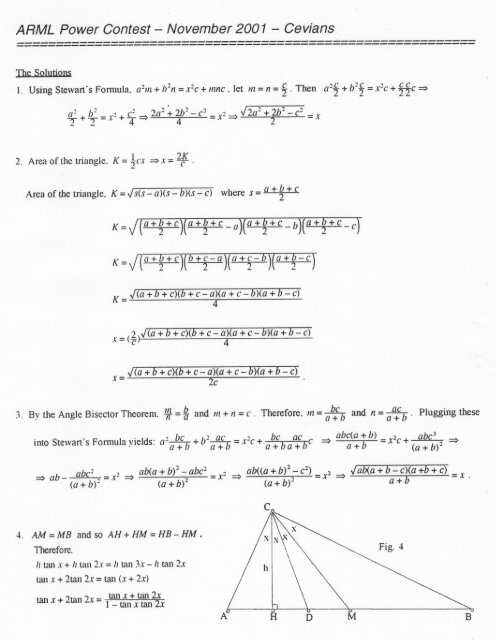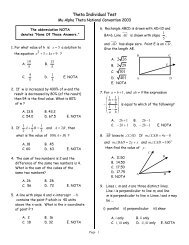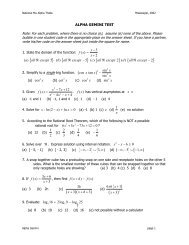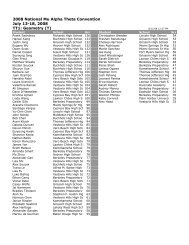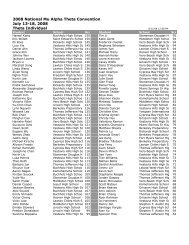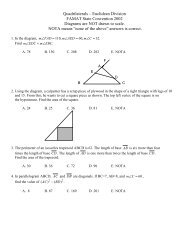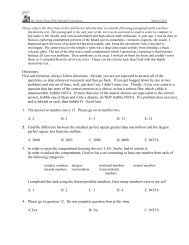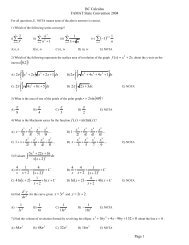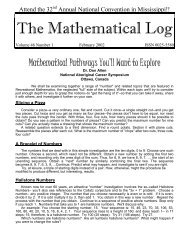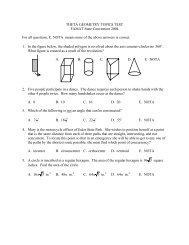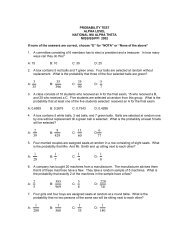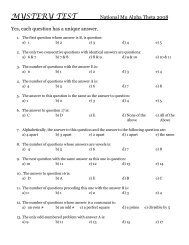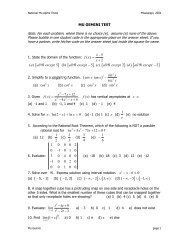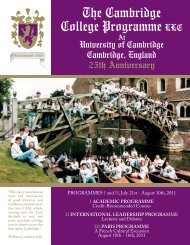Answers - Mu Alpha Theta
Answers - Mu Alpha Theta
Answers - Mu Alpha Theta
Create successful ePaper yourself
Turn your PDF publications into a flip-book with our unique Google optimized e-Paper software.
ARML Power Contest - November 2001 - Cevians<br />
----------------------------------------------------------<br />
The Solutions<br />
l. Using Stewart's Fommla, a~1I1+ b~n=x~e + 1I1ne. let 111=n =!. Then a~~+ b2~= x~e+ He ~<br />
a2 + b2 = ,". 2 + c2 2a2 ~2b2- e~ - ,.2 .;2a2+2b~- e~= ,.<br />
77" 4- 4 -"- 2 .-"<br />
2. Area of the triangle. K =~('x ~ x = 2f .<br />
Area of the triangle, K =.js(s - a)(s - bHs - e) where s =a + ~ + e<br />
K=V(a+~+e)(a+~+e a)(a+~+c-b)(a+~+c c)<br />
K = V(a + ~ + C)(b +~-a)( a +~-b)(a<br />
+ q-e)<br />
K ';«(1+ b + c)(b + c- aHa + c- b)(a + b -c)<br />
- 4<br />
,.- ( 1 )<br />
../ (a + b + c)(b + c - a)(a + e - b)(a + b - e)<br />
-"-c 4<br />
"/(a + b + c)(b + c-o)(a + c-b)(o + b- c)<br />
x= k .<br />
3. By the Angle Bisector Theorem. ':11=.g. and 111+ n = e. Therefore. 111= a~' band n = aa:.b' Plugging these<br />
into Stewart's Formula yields: a~ be + b~ ae =x~e + be ae e ~ abc(a + b) x2e + abe3 =><br />
. a + b a+5 a + b a + b a + b (a + b)2<br />
b abc2 - ~ ab(a + b)2- abe~- ~ ab«a + b)2- e2)- 2 ../ ab(a + b - e)(a +b + c)<br />
=> a-, -x ~ 2 -x ~ ,-x => b<br />
(a+b)- (a+b) (a+b)- a+<br />
x.<br />
4. AM=MB and so AH+HM=HB-HM.<br />
Therefore.<br />
II tan x + II tan 2x =II tan 3x - II tan 2x<br />
tan x + 2tan 2x = tan (x + 2x)<br />
Fig. 4<br />
tan X + 2tan 2x = tan x + tan 2x<br />
l-tanxtan2x<br />
M<br />
B
k'U1 X - tan: x l - Lan" x +1 - 2l tan4x-6tan1x+I=O =><br />
I-lan-x<br />
tan x = v'3:t 2./1 => x = tan- 'v'3:t 2./1 =><br />
x=22.5°or67.5° => x=22.5°, Therefore. LA =67,5°, LB=22.5°,and LC=90°,<br />
5. By Ceva's Theorem, ~~, IJ.-t'1: ' f/1. = 1, But since M is a midpoint. IJ.-t'1:=I and since CD is an angle<br />
bisector. ~~ = ~.<br />
Therefore. fI1. = %, Let CH= at and HA= bl . then at + bl = b , or I = a ~ b '<br />
By the Pythagorean Theorem. BH2 =AB~ - HA 1 , so<br />
BH1 =c: -l/I~ and BH~ = BC~ - CH~ , so BH~ = a~ - a~t~ ,<br />
'<br />
, ,<br />
Thereore. fi c- - I n- " =ao- , a-r " and r ' =~,<br />
,,-- r- S ubstitutmgor<br />
.' , , fi<br />
a- - b-<br />
.C<br />
: a: - c: :<br />
'a+b - .-~-'-<br />
l 1 and so ~=f!...:!..1l.<br />
a-'} a- - c- a- b " '<br />
I<br />
( _JL )<br />
A<br />
A<br />
6, Let s = the semi perimeter of .:lABC, then AE = s - c, EC = s - Q,<br />
CD = s - b. DB = s - c, BF = s - G, and FA = s - b,<br />
AE CD BF - oS-c s-b s-a-l<br />
R'DB'FA-s-a's-c's:::b- ,<br />
B<br />
D<br />
C<br />
Therefore. the cevians are concurrent. This is known as Geronne's Point.
ARML Power Contest - November 2001 - Cevians<br />
----------------------------------------------------------<br />
7, ~ DEF is the orthic triangle of<br />
~ ABC, with P the ortho center,<br />
the intersection of the altitudes,<br />
~AFP",~ CDP and so<br />
LFAP=.LDCP.<br />
Since quadrilateral AEPF has two<br />
right angles it must be cyclic. The<br />
same is true for quadrilaterdl<br />
CDPE.<br />
Because they intercept the same<br />
arc, L FAP =. L FEP and<br />
L DCP =. L PED. Therefore,<br />
L FEP =. L PED .<br />
" Fig,7<br />
The same reasoning can be used to show L EDP =. L FDP and L DFP =. L EFP and so DA,i!1J,andFe are<br />
bisectors of the angles of ~ DEF and so P is the incenter of ~ DEF,<br />
8. By Hero's Fonnula the areaof ~ABC is KABc=v's(s-14)(s-25)(s--I149) wheres= ~ +39 ,<br />
= V (-11492+ 39)( -11492+ 11 )( -11492- 11 )(39 - 1149) =";(392 - 1491(149 - 112) .,t2~=49, Using<br />
(3 If<br />
Routh's Theorem,the areaof ~PQR is KPQR=(1)~- S +5+1 3<br />
'KABc=(19) 80=MBC<br />
L K ' - th f h .. , , I K (28- Ii 80 216<br />
et .. - e area0 t e mtenorcevtantnange. =(28+ 4 + 1)(7+ 7 + 1)(4+ 1+ 1)' = IT '
10.<br />
(n) - I)~<br />
K I'QR=, I' . I' . Kllnc<br />
(n- + n + )(n- + n + )(n- + n + I)<br />
-KPQR<br />
K = ]<br />
ABC<br />
(II - I)(n~+ n + I))~<br />
(II~+II+I)'<br />
KPQR- (n - 1)~ - (n~- 2n + 1)<br />
K.~Bc- (n~+ n + I) - (n~+ n + I)<br />
11. Let cevial1s AD. /JE, and CE be concurrent at point<br />
P and let Q be the intersection AD' and /JE'. the<br />
isogonal col1iugates of ifD and /JE. Let the<br />
distances from P to sides lJl:. AL'.and lJl: be<br />
Fig. lla<br />
a'. 17'.and c' . respectively, and the distances from Q<br />
to the sides lJl:. AL',and lJl: be a". b", and c",<br />
respectively.<br />
Using ifD and ifD' and The Isogonal<br />
Theorem. ,< = P c" . Using IJE and /JE' and The<br />
c )<br />
D<br />
0<br />
A<br />
C<br />
Isogonal Theorem. ac: = a c ;;. Combining the two<br />
equationsusing multiplicationyields<br />
b' .£. - c" . fL..<br />
c' 0' - b" c"<br />
b' - a"<br />
(1-7J"<br />
Fig. lIb<br />
c<br />
Let CF"' be a cevian from C through point Q. By The Isogonal Theorem. CF'and CF"' must be isogonal.<br />
Therefore.isogonalsof concurrentceviansareconcurrent<br />
12. ~ Assume P is a point on symmedian AD. By<br />
the Isogonal Theorem. J=t. Because M is a<br />
I 1 Fig. 12<br />
midpoint. KABM=KACM and 2ct =2bll . Therefore.<br />
.£ - ll. and so X -.£<br />
b-t<br />
,v-b'<br />
~ Assume + = Ī c and M is the midpoint of lJl:.<br />
. )<br />
Usingthe same area logicas above, t = t and M C
so. by The Isogonal Theorem.AP (AD)and if}J are,isogonal. Since A!J is a median. AD must be a<br />
symmedian.<br />
13. Let AD be a symmedian and let BD = III and<br />
DC = n. From problem 12 above.t = f . . ()<br />
Because the\' share the samealtitude. ~ = ' n ".<br />
. AADC<br />
Fig. 13<br />
But KARD= !XC and K'IDc=!yb. So<br />
'hi = ~ = (fHfi) = (tHE) = ~~ .<br />
B<br />
14. Consider t1ABC with DE. a parallel to side<br />
\0<br />
IJC and AX.<br />
the angle bisector (Figure 14a).<br />
Let lYl! be the reflection of l5E through AX .<br />
Using congruent triangles. it is easy to prove<br />
that t1 ADE ==t1AD'E and so<br />
LADE ==L AD'E. Therefore. l5"E is ~<br />
c<br />
antiparallel to side IJC.<br />
Fig. 14a<br />
Using Figure 14b. since the median if}J bisects l5E<br />
at G and the fact that the reflection transfoITnation<br />
preserves distances. its reflection through AX will<br />
bisect the reflection of DE through ,.cr .<br />
Therefore,thesynunedianfrom A bisectsany<br />
E<br />
antiparallelto /Jl:.<br />
B<br />
L<br />
Fig. 14b<br />
C


